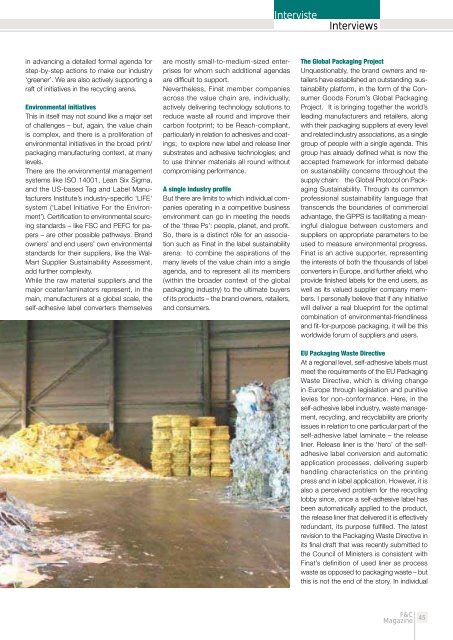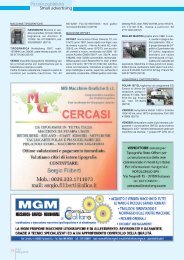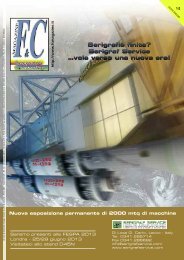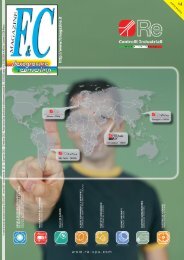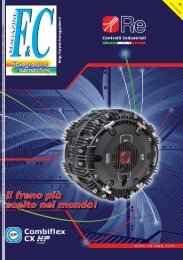One touch web review - international media - flexogravure
One touch web review - international media - flexogravure
One touch web review - international media - flexogravure
You also want an ePaper? Increase the reach of your titles
YUMPU automatically turns print PDFs into web optimized ePapers that Google loves.
in advancing a detailed formal agenda for<br />
step-by-step actions to make our industry<br />
‘greener’. We are also actively supporting a<br />
raft of initiatives in the recycling arena.<br />
Environmental initiatives<br />
This in itself may not sound like a major set<br />
of challenges – but, again, the value chain<br />
is complex, and there is a proliferation of<br />
environmental initiatives in the broad print/<br />
packaging manufacturing context, at many<br />
levels.<br />
There are the environmental management<br />
systems like ISO 14001, Lean Six Sigma,<br />
and the US-based Tag and Label Manufacturers<br />
Institute’s industry-specific ‘LIFE’<br />
system (‘Label Initiative For the Environment’).<br />
Certification to environmental sourcing<br />
standards – like FSC and PEFC for papers<br />
– are other possible pathways. Brand<br />
owners’ and end users’ own environmental<br />
standards for their suppliers, like the Wal-<br />
Mart Supplier Sustainability Assessment,<br />
add further complexity.<br />
While the raw material suppliers and the<br />
major coater/laminators represent, in the<br />
main, manufacturers at a global scale, the<br />
self-adhesive label converters themselves<br />
are mostly small-to-medium-sized enterprises<br />
for whom such additional agendas<br />
are difficult to support.<br />
Nevertheless, Finat member companies<br />
across the value chain are, individually,<br />
actively delivering technology solutions to<br />
reduce waste all round and improve their<br />
carbon footprint; to be Reach-compliant,<br />
particularly in relation to adhesives and coatings;<br />
to explore new label and release liner<br />
substrates and adhesive technologies; and<br />
to use thinner materials all round without<br />
compromising performance.<br />
A single industry profile<br />
But there are limits to which individual companies<br />
operating in a competitive business<br />
environment can go in meeting the needs<br />
of the ‘three Ps’: people, planet, and profit.<br />
So, there is a distinct rôle for an association<br />
such as Finat in the label sustainability<br />
arena: to combine the aspirations of the<br />
many levels of the value chain into a single<br />
agenda, and to represent all its members<br />
(within the broader context of the global<br />
packaging industry) to the ultimate buyers<br />
of its products – the brand owners, retailers,<br />
and consumers.<br />
Interviste<br />
Interviews<br />
The Global Packaging Project<br />
Unquestionably, the brand owners and retailers<br />
have established an outstanding sustainability<br />
platform, in the form of the Consumer<br />
Goods Forum’s Global Packaging<br />
Project. It is bringing together the world’s<br />
leading manufacturers and retailers, along<br />
with their packaging suppliers at every level<br />
and related industry associations, as a single<br />
group of people with a single agenda. This<br />
group has already defined what is now the<br />
accepted framework for informed debate<br />
on sustainability concerns throughout the<br />
supply chain: the Global Protocol on Packaging<br />
Sustainability. Through its common<br />
professional sustainability language that<br />
transcends the boundaries of commercial<br />
advantage, the GPPS is facilitating a meaningful<br />
dialogue between customers and<br />
suppliers on appropriate parameters to be<br />
used to measure environmental progress.<br />
Finat is an active supporter, representing<br />
the interests of both the thousands of label<br />
converters in Europe, and further afield, who<br />
provide finished labels for the end users, as<br />
well as its valued supplier company members.<br />
I personally believe that if any initiative<br />
will deliver a real blueprint for the optimal<br />
combination of environmental-friendliness<br />
and fit-for-purpose packaging, it will be this<br />
worldwide forum of suppliers and users.<br />
EU Packaging Waste Directive<br />
At a regional level, self-adhesive labels must<br />
meet the requirements of the EU Packaging<br />
Waste Directive, which is driving change<br />
in Europe through legislation and punitive<br />
levies for non-conformance. Here, in the<br />
self-adhesive label industry, waste management,<br />
recycling, and recyclability are priority<br />
issues in relation to one particular part of the<br />
self-adhesive label laminate – the release<br />
liner. Release liner is the ‘hero’ of the selfadhesive<br />
label conversion and automatic<br />
application processes, delivering superb<br />
handling characteristics on the printing<br />
press and in label application. However, it is<br />
also a perceived problem for the recycling<br />
lobby since, once a self-adhesive label has<br />
been automatically applied to the product,<br />
the release liner that delivered it is effectively<br />
redundant, its purpose fulfilled. The latest<br />
revision to the Packaging Waste Directive in<br />
its final draft that was recently submitted to<br />
the Council of Ministers is consistent with<br />
Finat’s definition of used liner as process<br />
waste as opposed to packaging waste – but<br />
this is not the end of the story. In individual<br />
F&C<br />
Magazine 45


